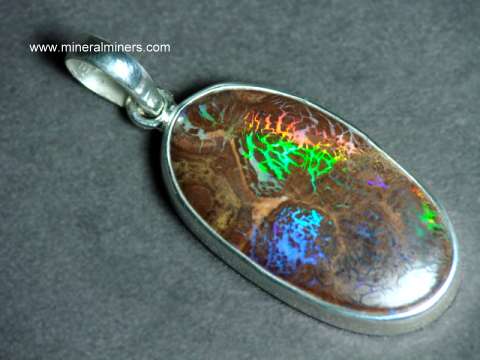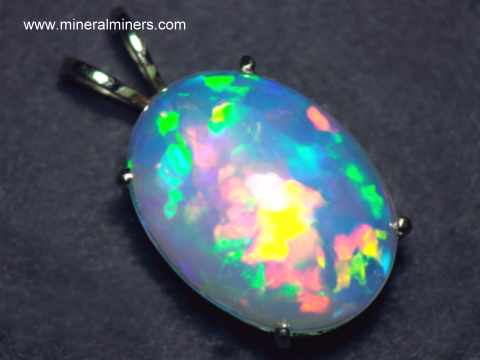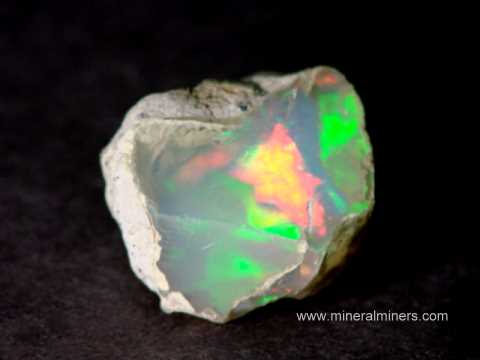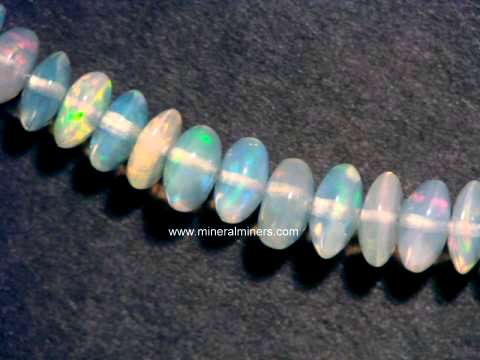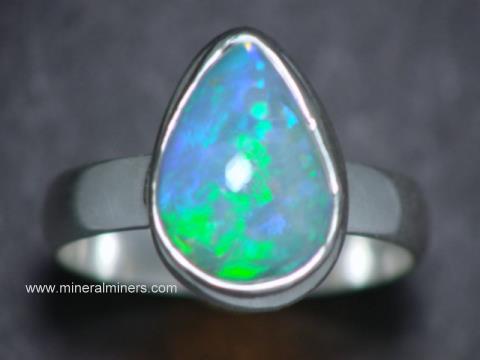


Enter our On-line Store to see genuine Opal Jewelry & Opal Gemstones
MINERALMINERS.COM® - Your Personal 'Link' Direct to the Opal Mines!TM
Opal Information
Opal is a variety of silica (Quartz). See also our other Quartz Varieties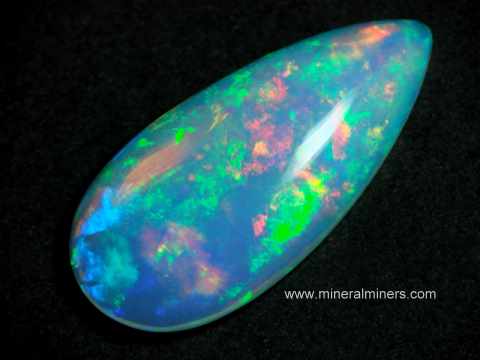
Opal Info & Opal Information Topics
Natural Opal Products For Sale:
Return to the Index of Opal Information Topics
OPAL PHYSICAL PROPERTIES
- Opal Chemical composition: SiO2-nH2O
- Class: tectosilicate
- Crystal system: generally amorphous packing of hydrous silica micro-spheroids, ordered packing in precious opal causes play of color
- Crystal habit: amorphous
- Specific gravity: 2.00-2.25
- Index of refraction: 1.44-1.46
- Hardness: 5 to 6
- Color: pale hues of gray, colorless, white, green, blue, red, orange, brown or yellow, may show a play of colors
- Luster: vitreous to resinous
- Transparency: translucent to transparent
- Cleavage: no cleavage
- Fracture: conchoidal
OPAL BACKGROUND INFORMATION
Opal is a hydrous silica mineral composed of SiO2 with some water incorporated within its structure. The water percent can vary up to about 20%.
Opal is not truly amorphous as it is composed of silica micro-spheres with ordered packing.
The SiO2 in opal does not have a three-dimensional crystalline structure like it does in all of the many different varieties of quartz. Instead, opal has closely packed silica spheres in layers with hexagonal packing and/or cubic closest packing. Voids between the closely packed silica sphere layers contain air or water.
In precious opal, the light passing through the opal is diffracted upon striking the voids resulting in a play of spectral colors. This phenomenon is rare, and such precious opals are highly prized as gemstones. When precious opal is semi-transparent to transparent it is known as crystal opal.
When natural opal has no play of colors it is known as common opal which can have a natural body color in shades of pink, green, yellow, blue, brown or red due to impurities, however it has no play of colors.
Return to the Index of Opal Information Topics
OPAL OCCURRENCE AND DIAGNOSTIC FEATURES
Opal often forms by precipitation from silica-rich meteoric waters or low temperature hypogene solutions.
Large opaline deposits can form by accumulation of siliceous tests of silica-secreting diatoms in both freshwater and seawater.
Opal is commonly found lining and/or filling cavities in rock.
Opal occurs commonly as a petrifying agent in fossil wood, bone, and other organic debris buried in volcanic tuffs.
Siliceous sinter is opal that was deposited by geysers and hot springs.
Colorless clear opal with botryoidal surfaces is known as hyalite.
Opal is characterized by its lesser hardness than quartz varieties of similar appearance, as well as by its water content and its specific
gravity, refractive index and luster.
Return to the Index of Opal Information Topics
OPAL HISTORICAL INFORMATION AND USES
Opal has been used as gemstones and other ornamental objects for thousands of years.
The name "opal" was derived from the Sanskrit upala which meant "precious stone".
Opaline diatomaceous earth or diatomite has many uses as fillers, abrasives, and in insulation.
In medieval times opal was said to give its wearer improved eye sight and to preserve its wearer from disease.
Wearing an opal was also said to render its wearer invisable.
Precious opals show a play of spectral colors.
Until just a few years ago, the main source of precious opal for the gem trade has been Australia. Natural opal that formed in ironstone matrix at Queensland, Australia is popularly known as boulder opal.
The recently discovered opal find near Delanta in the Welo Province of Ethiopia is now producing very stable jewelry grade precious crystal opals with bright plays of green, red, blue, and orange colors in beautiful patterns ranging from pin-fire to broad-flash. This new Ethiopian precious crystal opal is completely natural and has proven to be just as hard and stable as fine Australian opals and Brazilian opal. The body color of this new Ethiopian opal ranges from golden-brown to white to colorless to blue, and the transparency varies from translucent to crystal clear. The very transparent Ethiopian opals with color play inside are popularly known as crystal opal gemstones and sometimes they are called jelly opal gemstones when very clear with a gelatinous appearance. Some of these Ethiopian opals tend to absorb water and change their transparency and colors if placed in water, and then they recover their original play of color and transparency after being removed from the water and drying out. This type of natural opal is known as hydrophane opal. You can see examples of these completely natural Ethiopian opals set into genuine Ethiopian opal jewelry designs in solid 14k gold and sterling silver.
See also some examples of amazing Ethiopian opal gem grade rough specimens.
Opal is a traditional birthstone jewelry gift for birthdays in the month of October.
See our selection of handcrafted natural opal jewelry gifts including Opal Necklaces, Opal Earrings, Opal Bracelets, and Opal Rings.
Return to the Index of Opal Information Topics
OPAL METAPHYSICAL PROPERTIES
Opal is said to inspire creativity and to refresh your energy.
Wearing opal jewelry is said to bring harmony, emotional balance, hope, love, and joy.
Opal is also said to calm nerves, and to help remove toxins from the body.For more in-depth metaphysical information, see our Metaphysical Books section.
Return to the Index of Opal Information Topics
See all of our natural quartz varieties:
Varieties of QUARTZ
Opal Products in our On-Line Store
Go up to the top of this opal information page
Last Updated: October 10, 2025
© Copyright 1998-2025 Gem & Mineral Miners, Inc.® All Rights Reserved.
